Cancer NCLEX style questions – Flashcards
Unlock all answers in this set
Unlock answersquestion
A nurse cares for a client who has a genetic mutation that increases the risk for colon cancer. The client states that he does not want any family to know about this result. How should the nurse respond? a. "It is required by law that you inform your siblings and children about this result so that they also can be tested and monitored for colon cancer." b. "It is not necessary to tell your siblings because they are adults, but you should tell your children so that they can be tested before they decide to have children of their own." c. "It is not required that you tell anyone about this result. However, your siblings and children may also be at risk for colon cancer and this information might help them."
answer
ANS: C This situation represents an ethical dilemma. It is the client's decision whether to disclose the information. However, the information can affect others in the client's family. The law does not require the client to tell family members about the results, nor can the client be held liable for not telling them. The nurse may consider it ethically correct for the client to tell family members so that they can take action to prevent the development of cancer, but the nurse must respect the client's decision.
question
A nurse cares for a client who recently completed genetic testing that revealed that she has a BRCA1 gene mutation. Which actions should the nurse take next? (Select all that apply.) a. Discuss potential risks for other members of her family. b. Assist the client to make a plan for prevention and risk reduction. c. Disclose the information to the medical insurance company. d. Recommend the client complete weekly breast self-examinations. e. Assess the client's response to the test results. f. Encourage support by sharing the results with family members.
answer
ANS: A, B, E The medical-surgical nurse can assess the client's response to the test results, discuss potential risks for other family members, encourage genetic counseling, and assist the client to make a plan for prevention, risk reduction, and early detection. For some positive genetic test results, such as having a BRCA1 gene mutation, the risk for developing breast cancer is high but is not a certainty. Because the risk is high, the client should have a plan for prevention and risk reduction. One form of prevention is early detection. Breast self-examinations may be helpful when performed monthly, but those performed every week may not be useful, especially around the time of menses. A client who tests positive for a BRCA1 mutation should have at least yearly mammograms and ovarian ultrasounds to detect cancer at an early stage, when it is more easily cured.
question
A nurse obtains health histories when admitting clients to a medical-surgical unit. With which client should the nurse discuss predisposition genetic testing? a. Middle-aged woman whose mother died at age 48 of breast cancer b. Young man who has all the symptoms of rheumatoid arthritis c. Pregnant woman whose father has sickle cell disease d. Middle-aged man of Eastern European Jewish ancestry
answer
ANS: A A client with a family history of breast cancer should be provided information about predisposition testing. Predisposition testing should be discussed with clients who are at high risk of hereditary breast, ovarian, and colorectal cancers so that the client can engage in heightened screening activities or interventions that reduce risk.
question
The nursing instructor explains the difference between normal cells and benign tumor cells. What information does the instructor provide about these cells? a. Benign tumors grow through invasion of other tissue. b. Benign tumors have lost their cellular regulation from contact inhibition. c. Growing in the wrong place or time is typical of benign tumors. d. The loss of characteristics of the parent cells is called anaplasia.
answer
ANS: C Benign tumors are basically normal cells growing in the wrong place or at the wrong time. Benign cells grow through hyperplasia, not invasion. Benign tumor cells retain contact inhibition. Anaplasia is a characteristic of cancer cells **Benign has smaller than normal nucleus**
question
A nurse has taught a client about dietary changes that can reduce the chances of developing cancer. What statement by the client indicates the nurse needs to provide additional teaching? a. "Foods high in vitamin A and vitamin C are important." b. "I'll have to cut down on the amount of bacon I eat." c. "I'm so glad I don't have to give up my juicy steaks." d. "Vegetables, fruit, and high-fiber grains are important."
answer
ANS: C To decrease the risk of developing cancer, one should cut down on the consumption of red meats and animal fat. The other statements are correct.
question
A nurse is participating in primary prevention efforts directed against cancer. In which activities is this nurse most likely to engage? (Select all that apply.) a. Demonstrating breast self-examination methods to women b. Instructing people on the use of chemoprevention c. Providing vaccinations against certain cancers d. Screening teenage girls for cervical cancer e. Teaching teens the dangers of tanning booths
answer
ANS: B, C, E Primary prevention aims to prevent the occurrence of a disease or disorder, in this case cancer. Secondary prevention includes screening and early diagnosis. Primary prevention activities include teaching people about chemoprevention, providing approved vaccinations to prevent cancer, and teaching teens the dangers of tanning beds. Breast examinations and screening for cervical cancer are secondary prevention methods.
question
A client receiving intravenous chemotherapy asks the nurse the reason for wearing a mask, gloves, and gown while administering drugs to the client. What is the nurse's best response? a."These coverings protect you from getting an infection from me." b."I am preventing the spread of infection from you to me or any other client here." c."The policy is for any nurse giving these drugs to wear a gown, gloves, and mask." d."The clothing protects me from accidentally absorbing these drugs."
answer
ANS: D Most chemotherapy drugs are absorbed through the skin and mucous membranes. As a result, health care workers who prepare or give these drugs, especially nurses and pharmacists, are at risk for absorbing them. Even at low doses, chronic exposure to chemotherapy drugs can affect health. The Oncology Nursing Society and the Occupational Safety and Health Administration (OSHA) have specific guidelines for using caution and wearing protective clothing whenever preparing, giving, or disposing of chemotherapy drugs.
question
A client is on chemotherapy and has a platelet count of 25,000. Which intervention is most important to teach this client? a. "Eat a low-bacteria diet." b. "Take your temperature daily." c. "Use a soft-bristled toothbrush."
answer
ANS: C This client has thrombocytopenia, which is a common side effect of chemotherapy. This increases the client's risk for prolonged bleeding in response to even minor injury, especially from highly vascular areas such as the gums. The client should be taught to use a soft toothbrush. A low-bacteria diet and daily temperature monitoring would be used in a client who is neutropenic.
question
A client with chemotherapy-induced bone marrow suppression has received filgrastim (Neupogen). Which laboratory finding indicates that this therapy is effective for the client? a.Hematocrit is 28%. b.Hematocrit is 38%. c.Segmented neutrophil count is 2500/mm3. d.Segmented neutrophil count is 3500/mm3.
answer
ANS: D Filgrastim is a single-lineage growth factor that stimulates the maturation and release of only segmented neutrophils. This drug is not given unless the neutrophil count is dangerously low. The near-normal range of neutrophils indicates effective therap
question
A nurse is reviewing the white blood cell count with differential for a client receiving chemotherapy for cancer. Which finding alerts the nurse to the possibility of sepsis? a.Total white blood cell count is 9000/mm3. b.Lymphocytes outnumber basophils. c."Bands" outnumber "segs." d.Monocyte count is 1800/mm3.
answer
ANS: C Normally, mature segmented neutrophils ("segs") are the major population of circulating leukocytes, constituting 55% to 70% of the total white blood cell count. Less than 3% to 5% of circulating white blood cells should be the less mature band neutrophils. A left shift occurs when the bone marrow releases more immature neutrophils than mature neutrophils. This condition indicates severe infection with possible sepsis and must be explored further.
question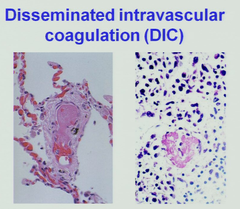
Why is sepsis an oncological emergency?

answer
Can trigger disseminated Intravascular coagulation (DIC) It is life-threatening
question
Why is SIADH an ocological emergency?
answer
Causes fluid retention, hyponatremia. Left untreated can progress to seizure, coma, and death.
question
A client has small cell lung cancer. Which laboratory result requires immediate intervention by the nurse? a. Serum potassium of 5.1 mEq/L b. Serum sodium of 118 mEq/L
answer
ANS: B In the syndrome of inappropriate antidiuretic hormone hypersecretion (SIADH), secretion of antidiuretic hormone (ADH) from the posterior pituitary gland is increased, causing the client to reabsorb water from the distal convoluted tubule and collecting duct. As a result, weight increases, and serum sodium and hematocrit levels are diluted. Potassium is slightly high, but very low sodium places the client at risk for seizures and even death
question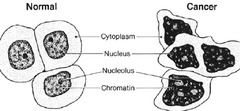
Compare normal and cancer cells.

answer
Normal: Large cytoplasm, single nucleus, single nucleolus, fine chromatin. Cancer: Small cytoplasm, multiple nuclei, multiple and large nucleoli, coarse chromatin.
question
The nurse is administering a combination of three different antineoplastic drugs to a patient who has metastatic breast cancer. Which statement best describes the rationale for combination therapy? a. There will be less nausea and vomiting. b.Increased cancer-cell killing will occur. c.The drugs will prevent metastasis. d.Combination therapy reduces the need for radiation therapy.
answer
ANS: B Because drug-resistant cells commonly develop, exposure to multiple drugs with multiple mechanisms and sites of action will destroy more subpopulations of cells. The other options are incorrect.
question
When giving chemotherapy as cancer treatment, the nurse recognizes that toxicity to rapidly growing normal cells also occurs. Which rapidly growing normal cells are also harmed by chemotherapy? (Select all that apply.) a.Bone marrow cells b.Retinal cells c.Hair follicle cells d.Nerve myelin cells e. Gastrointestinal (GI) mucous membrane cells
answer
ANS: A, C, E Chemotherapy toxicities generally stem from the fact that chemotherapy drugs affect rapidly dividing cells—both harmful cancer cells and healthy, normal cells. Three types of rapidly dividing human cells are the cells of hair follicles, GI tract cells, and bone marrow cells. The other options are incorrect.
question
One patient has cancer of the bone; another has cancer in the connective tissues of the thigh muscles; a third patient has cancer in the vascular tissues. These patients have a type of tumor referred to as a a.sarcoma. b.leukemia. c.carcinoma. d.lymphoma.
answer
ANS: A Sarcomas are malignant tumors that arise from connective tissues. These tissues can be found in bone, cartilage, muscle, blood, lymphatic, and vascular tissues. The other options are incorrect.
question
A patient who has cancer is about to begin chemotherapy. The patient asks the nurse why two chemotherapeutic agents are being used instead of just one. Which response by the nurse is correct? a. "The drugs may be given in less toxic doses if two drugs are used." b. "Two agents used together can have synergistic effects." c. "Use of two drugs will increase tumorcidal activity in the G0 phase of the cell." d. "Using two agents will shorten the length of time chemotherapy is needed."
answer
ANS: B Using two or more chemotherapeutic agents can have a synergistic effect. Combination therapy typically uses two drugs with different dose-limiting toxicities, but the use of more than one drug does not allow for using less toxic doses. Combination therapy allows cell kill in all phases of the cell cycle. Combination therapy does not shorten the length of time chemotherapy is needed.
question
The nurse is teaching a patient who will begin receiving targeted therapy for cancer. The patient asks how targeted therapy differs from other types of chemotherapies. The nurse will explain that targeted therapy a. damages cancer cell DNA to prevent cell replication. b. directly kills or damages cancerous cells. c. interferes with specific molecules in cancer cells. d. prevents metastasis of cancer cells.
answer
ANS: C Targeted therapy differs from traditional cancer chemotherapy by taking advantage of biologic features particular to cancer cells and targeting specific mechanisms. They block the growth and spread of cancer by interfering with specific molecules within the cancer cells. Traditional chemotherapeutic agents damage cell DNA of cancer cells as well as normal cells. Targeted therapies do not directly kill or damage cancer cells or prevent metastasis.
question
Rituximab (Rituxan) has been prescribed for a patient who has chronic lymphocyte leukemia. When assessing the patient prior to the treatment, what assessment question is the nurse's priority?
answer
Do you have any history of heart disease or irregular heart rhythms
question
A patient with acute lymphoblastic leukemia (ALL) is receiving imatinib on an inpatient basis. When planning the care of this patient, what assessment should be specified in the patient's plan of nursing care?
answer
daily weights
question
what do you watch during the 1st infusion with Rituximab
answer
respiratory and cardiac status
question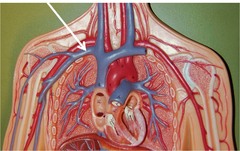
The use of which venous site reduces risk of extravasation during chemo treatments?

answer
Subclavian vien
question
A client with vaginal cancer is being treated with a radioactive vaginal implant. The client's husband asks the nurse if he can spend the night with his wife. The nurse should explain that: A. Overnight stays by family members is against hospital policy. B. There is no need for him to stay because staffing is adequate. C. His wife will rest much better knowing that he is at home. D. Visitation is limited to 30 minutes when the implant is in place.
answer
D. Visitation is limited to 30 minutes when the implant is in place.
question
A client has cancer of the pancreas. The nurse should be most concerned about which nursing diagnosis? A.Alteration in nutrition B.Alteration in bowel elimination C. Alteration in skin integrity D. Ineffective individual coping
answer
A.Alteration in nutrition
question
The registered nurse is making assignments for the day. Which client should be assigned to the pregnant nurse? A.The client with HIV B. The client with a radium implant for cervical cancer C. The client with RSV (respiratory synctial virus) D.The client with cytomegalovirus
answer
A.The client with HIV
question
Which health care worker should not be assigned to care for the client with a radium implant for vaginal cancer? A.The doctor who is six months postpartum B.The Nursing Assistant who is pregnant C.The RN who is allergic to iodine D.The RN with a three-year-old at home
answer
The Nursing Assistant who is pregnant
question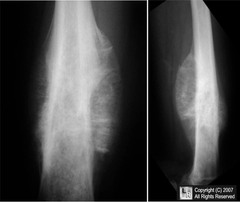
A client is admitted with a Ewing's sarcoma. which symptoms would be expected due to this tumor's location? A. Hemiplegia B. Aphasia C. Nausea D. Bone Pain

answer
D. Bone Pain why? Sarcoma is a type of bone cancer, therefor, bone pain would be expected
question
A client with acute leukemia develops a low white blood cell count. In addition to the institute of isolation the nurse should: A. Request that food be served with disposable utensils B. Ask the client to wear a mask when visitors are present C. Prep IV with mild soap, water, and alcohol D. Provide foods in seal single serving packages
answer
D. Provide foods in seal single serving packages why? Because the client is immune-suppressed, foods should be served in sealed containers, to avoid food contaminants.
question
A client with leukemia is receiving Trimetrexate. After reviewing the client's chart, the physician orders Wellcovorin (leucovorin calcium). The rationale for administering leucovorin calcium to a client receiving Trimetrexate is to: A. Treat iron-deficiency anemia caused by chemotherapeutic agents B. Create a synergistic effect that shortens treatment time C. Increase the number of circulating neutrophils D. Reverse drug toxicity and prevent tissue damage
answer
Answer D is correct. Leucovorin is the antidote for Methotrexate and Trimetrexate which are folic acid antagonists. Leucovorin is a folic acid derivative. Answers A, B, and C are incorrect because Leucovorin does not treat iron deficiency, increase neutrophils, or have a synergistic effect.
question
A 33-year-old male is being evaluated for possible acute leukemia. Which of the following would the nurse inquire about as a part of the assessment? A. The client collects stamps as a hobby. B. The client recently lost his job as a postal worker. C. The client had radiation for treatment of Hodgkin's disease as a teenager. D. The client's brother had leukemia as a child.
answer
Answer C is correct. Radiation treatment for other types of cancer can result in leukemia. Some hobbies and occupations involving chemicals are linked to leukemia, but not the ones in these answers; therefore, answers A and B are incorrect. Answer D is incorrect because the incidence of leukemia is higher in twins than in siblings.
question
An African American client is admitted with acute leukemia. The nurse is assessing for signs and symptoms of bleeding. Where is the best site for examining for the presence of petechiae? A. The abdomen B. The thorax C. The earlobes D. The soles of the feet
answer
Answer D is correct. Petechiae are not usually visualized on dark skin. The soles of the feet and palms of the hand provide a lighter surface for assessing the client for petichiae. Answers A, B, and C are incorrect because the skin might be too dark to make an assessment.
question
A client with acute leukemia is admitted to the oncology unit. Which of the following would be most important for the nurse to inquire? A. "Have you noticed a change in sleeping habits recently?" B. "Have you had a respiratory infection in the last 6 months?" C. "Have you lost weight recently?" D. "Have you noticed changes in your alertness?"
answer
Answer B is correct. The client with leukemia is at risk for infection and has often had recurrent respiratory infections during the previous 6 months. Insomnolence, weight loss, and a decrease in alertness also occur in leukemia, but bleeding tendencies and infections are the primary clinical manifestations; therefore, answers A, C, and D are incorrect.
question
Which of the following would be the priority nursing diagnosis for the adult client with acute leukemia? A. Oral mucous membrane, altered related to chemotherapy B. Risk for injury related to thrombocytopenia C. Fatigue related to the disease process D. Interrupted family processes related to life-threatening illness of a family member
answer
Answer B is correct. The client with acute leukemia has bleeding tendencies due to decreased platelet counts, and any injury would exacerbate the problem. The client would require close monitoring for hemorrhage, which is of higher priority than the diagnoses in answers A, C, and D, which are incorrect.
question
A client being treated for advanced breast cancer with chemotherapy reports that she must be allergic to one of her drugs because her entire face is swollen. What assessment does the nurse perform? A. Asks whether the client has other known allergies B. Checks the capillary refill on fingernails bilaterally C. Examines the client's neck and chest for edema and engorged veins D. Compares blood pressure measured in the right arm with that in the left arm
answer
C. Examines the client's neck and chest for edema and engorged veins Rationale: The client's swollen face indicates possible superior vena cava syndrome, which is an oncologic emergency. Manifestations result from the blockage of venous return from the head, neck, and upper trunk. Early manifestations occur when the client arises after a night's sleep and include edema of the face, especially around the eyes, and tightness of the shirt or blouse collar. As the compression worsens, the client develops engorged blood vessels and erythema of the upper body, edema in the arms and hands, dyspnea, and epistaxis. Interventions at this stage are more likely to be successful. Late manifestations include hemorrhage, cyanosis, mental status changes, decreased cardiac output, and hypotension. Death results if compression is not relieved.
question
A client receiving high-dose chemotherapy who has bone marrow suppression has been receiving daily injections of epoetin alfa (Procrit). Which assessment finding indicates to the nurse that today's dose should be held and the health care provider notified? A. Hematocrit of 28% B. Total white blood cell count of 6200 cells/mm3 C. Blood pressure change from 130/90 mm Hg to 148/98 mm Hg D. Temperature change from 99° F (37.2° C) to 100° F (37.8° C)
answer
C. Blood pressure change from 130/90 mm Hg to 148/98 mm Hg Rationale Epoetin alfa and other erythropoiesis-stimulating agents (ESAs) such as darbepoetin alfa (Aranesp) and epoetin alfa (Epogen, Procrit) increase the production of many blood cell types, not just erythrocytes, which increases the client's risk for hypertension, blood clots, strokes, and heart attacks, especially among older adults. Dosing is based on individual client hemoglobin and hematocrit levels to ensure that just enough red blood cells are produced to avoid the need for transfusion but not to bring hemoglobin or hematocrit levels up to normal. The increased blood pressure is an indication to stop this therapy immediately.
question
Which statement made by the client allows the nurse to recognize whether the client who is receiving brachytherapy for ovarian cancer understands the treatment plan? A. "I may lose my hair during this treatment." B. "I must be positioned in the same way during each treatment." C. "I will have a radioactive device in my body for a short time." D. "I will be placed in a semiprivate room for company."
answer
C. "I will have a radioactive device in my body for a short time." Rationale A. Side effects of radiation therapy are site specific. B. The client undergoing teletherapy (external beam radiation) must be positioned precisely in the same position each time. C. Brachytherapy refers to short-term insertion of a radiation source. D. The client who is receiving brachytherapy must be in a private room.
question
The client receiving chemotherapy will experience the lowest level of bone marrow activity and neutropenia during which period? A. Peak B. Trough C. Nadir D. Adjuvant
answer
C. Nadir Rationale A. The peak of bone marrow function occurs when the client's blood levels are at their highest. B. Trough, which means low, is typically used in reference to drug levels. C. The lowest point of bone marrow function is referred to as the nadir. D. Adjuvant refers to use of radiation therapy or surgery along with chemotherapy in cancer treatment.
question
The registered nurse is teaching a nursing student about the importance of observing for bone marrow suppression during chemotherapy. Select the person who displays bone marrow suppression. A. Client with hemoglobin of 7.4 and hematocrit of 21.8 B. Client with diarrhea and potassium level of 2.9 mEq/L C. Client with 250,000 platelets D. Client with 5000 white blood cells/mm3
answer
A. Client with hemoglobin of 7.4 and hematocrit of 21.8 Rationale Bone marrow suppression causes anemia, leukopenia, and thrombocytopenia; this client has anemia demonstrated by low hemoglobin and hematocrit.
question
Which client problem does the nurse set as the priority for the client experiencing chemotherapy-induced peripheral neuropathy? A. Potential for lack of understanding related to side effects of chemotherapy B. Risk for Injury related to sensory and motor deficits C. Potential for ineffective coping strategies related to loss of motor control D. Altered sexual function related to erectile dysfunction
answer
B. Risk for Injury related to sensory and motor deficits Rationale A. Although this information may be helpful, the priority is the client's safety because of lack of sensation or innervation. B. The highest priority is safety. C. The nurse should address the client's coping, after providing for safety. D. Erectile dysfunction may be a manifestation of peripheral neuropathy, but the priority is the client's safety.
question
The nurse is caring for a client who is receiving rituximab (Rituxan) for treatment of lymphoma. It is essential for the nurse to observe for which side effect?
answer
Allergy is the most common side effect.
question
Which intervention will be most helpful in preventing disseminated intravascular coagulation (DIC)? A. Monitoring platelets B. Administering packed red blood cells C. Using strict aseptic technique to prevent infection D. Administering low-dose heparin therapy for clients on bedrest
answer
C. Using strict aseptic technique to prevent infection **Sepsis is a major cause of DIC, especially in the oncology client. ***
question
When caring for a client with suspected syndrome of inappropriate antidiuretic hormone secretions (SIADH), the nurse reviews the medical record to uncover which signs and symptoms consistent with this syndrome? (SATA) A. Hyponatremia B. Mental status changes C. Azotemia D. Bradycardia E. Weakness
answer
A. Hyponatremia B. Mental status changes E. Weakness
question
The nurse anticipates administering which medication to treat hyperuricemia associated with tumor lysis syndrome (TLS)? A. Recombinant erythropoietin (Procrit) B. Allopurinol (Zyloprim) C. Potassium chloride D. Radioactive iodine 131
answer
B. Allopurinol (Zyloprim) Rationale A. Tumor lysis syndrome results in hyperuricemia (elevation of uric acid in the blood), hyperkalemia, and other electrolyte imbalances; Procrit is used to increase red blood cell (RBC) production and is not a treatment for hyperuricemia. B. Tumor lysis syndrome results in hyperuricemia, Allopurinol decreases uric acid production and is indicated in TLS. C. Tumor lysis syndrome results in hyperuricemia, hyperkalemia, and other electrolyte imbalances; administering additional potassium is dangerous. D. Radioactive iodine 131 is indicated in the treatment of thyroid cancer, not TLS
question
Which manifestation of an oncologic emergency requires the nurse to contact the health care provider immediately? A. New onset of fatigue B. Edema of arms and hands C. Dry cough D. Weight gain
answer
B. Edema of arms and hands Rationale Edema of the arms and hands indicates worsening compression of the superior vena cava consistent with superior vena cava syndrome. The compression must be relieved immediately, often with radiation therapy, because death can result without timely intervention.
question
Which precaution is most important for the nurse to teach a client receiving radiation therapy for head and neck cancer? A. Avoid eating red meat during treatment. B. Pace your leisure activities to prevent fatigue. C. See your dentist twice yearly for the rest of your life. D. Avoid using headphones or headsets until your hair grows back.
answer
C. See your dentist twice yearly for the rest of your life. Rationale: Radiation therapy that is directed in or around the oral cavity has a variety of actions that increase the risk for dental caries (cavities) and tooth decay. The salivary glands are affected, which changes the composition of the person's saliva and often causes "dry mouth." This result allows rapid bacterial overgrowth, which leads to cavity formation. In addition, the radiation damages the integrity of the enamel and also damages some of the living cells in the tooth. All contribute to an increased risk for dental infections and cavities.
question
How would the nurse define the term nadir to a client?
answer
Nadir refers to the average number of days it takes for a chemotherapeutic drug to have its peak effect on the bone marrow, which would coincide with the client's lowest white blood count and highest risk for infection or bleeding.
question
The nurse would anticipate administering which medication to clients receiving high-dose methotrexate?
answer
Leucovorin is given to block the systemic toxic effect of high-dose methotrexate. It is a form of folic acid that does not require dihydrofolate reductase to produce folic acid. Therefore, it is used to prevent or treat toxicity induced by methotrexate, a folic acid antagonist. All of the other options are chemotherapeutic drugs, which are not specifically associated with methotrexate.
question
The nurse should teach the client about which expected adverse effect of filgrastim (Neupogen)?
answer
Filgrastim increases the production of WBCs in the bone marrow, triggering the common adverse effect of bone pain. (Cranking up the bone marrow=BONE PAIN)
question
The nurse anticipates a client with low platelets will be prescribed which drug to stimulate platelet production?
answer
Oprelvekin stimulates the production of platelets that results from chemo induced thrombocytopenia.
question
When providing education to a client undergoing antineoplastic drug therapy, the nurse instructs the client to immediately notify the health care provider for which signs and symptoms? (Lilley Chapter 46)
answer
The client must contact the health care provider immediately if any of the listed signs or symptoms occur: · Fever or chills with a temperature higher than 100.5° F (38.1° C) · New sores or white patches in the mouth or throat · Swollen tongue with or without cracks and bleeding · Bleeding gums · Dry, burning, "scratchy," or "swollen" throat · A cough that is new and persistent · Changes in bladder function or patterns · Blood in the urine · Changes in gastrointestinal or bowel patterns, including "heartburn" or nausea, vomiting, constipation, or diarrhea lasting longer than 2 or 3 days · Blood in the stools
question
When teaching a client receiving paclitaxel (Taxol), the nurse should instruct the client about which common adverse effect?
answer
Myalgias and arthralgia (joint pain) are common adverse effects of paclitaxel that the client should be prepared to expect.
question
Which are general adverse effects of chemotherapy?
answer
Bone marrow suppression leads to leukopenia, neutropenia, and thrombocytopenia. Alopecia is a common adverse reaction to antineoplastic drugs.
question
The nurse is discussing the use of alkylating drugs with a client. What is the best way for the nurse to describe the action of alkylating drugs on cancer cells?
answer
They alter the chemical structure of the deoxyribonucleic acid (DNA). The alkylating drugs work by preventing cancer cells from reproducing. Specifically, they alter the chemical structure of the cells' DNA, which is essential to the reproduction of any cell. This stops the cancer from reproducing or spreading.
question
What is considered a major dose-limiting adverse effect of doxorubicin (Adriamycin)? Hepatoxicity Nephrotoxicity Cardiomyopathy Hemorrhagic cystitis
answer
Clients receiving doxorubicin need to be monitored for cardiac toxicity. There is a lifetime limited dose that clients are allowed to receive to minimize the occurrence of cardiomyopathy. *monitor EKGs before and after can cause CHF*
question
When a client is receiving cyclophosphamide (Cytoxan), the nurse should advise the client to drink plenty of fluids to prevent which condition?
answer
Hemorrhagic cystitis (Clients receiving cyclophosphamide should drink at least 2 to 3 L of fluid before, during, and after administration to prevent hemorrhagic cystitis)
question
Combinations of antineoplastic drugs are frequently used for which purpose? (Select all that apply.) A Prevent drug resistance B Lower cost of treatment C Decrease drug tolerance D Provide a synergistic action E Decrease the severity of adverse effects.
answer
A, D, E Administering a combination of antineoplastic drugs allows for smaller doses of each, which can minimize the severity of adverse effects and help prevent drug resistance. Additionally, there is a synergistic action between some of the medications. Decreasing cost is not a benefit of combination therapy
question
The client receives nolvadex (tamoxifen) for treatment of breast cancer. She asks the nurse why the medicine works. What is the best response by the nurse? 1. "Tamoxifen works by blocking estrogen receptors on breast tissue." 2. "Tamoxifen works by inhibiting the cellular mitosis of breast cancer." 3. "Tamoxifen works by inhibiting the metabolism of breast cancer cells." 4. "Tamoxifen works by binding to the DNA of breast cancer cells."
answer
Correct Answer: 1 Rationale 1: Breast cancer is dependent on estrogen for growth. nolvadex (Tamoxifen) acts by blocking estrogen receptors; the tumor is deprived of estrogen.
question
grows slowly, localized, encapsulated, well differentiated cells, no metastasis, not harmful to host.
answer
Benign
question
Grows rapidly, infiltrates surrounding tissues, not encapsulated, poorly differentiated, metastasis present, always harmful
answer
Malignant
question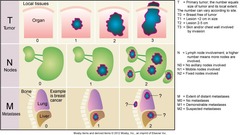
In staging and grading neoplasm TNM system is used. TNM stands for: A Time, neoplasm, mode of growth B. Tumor, node, metastasis C Tumor, neoplasm, mode of growth D Time, node, metastasis

answer
B. TNM stands for tumor, node, and metastasis.
question
Breast self examination (BSE) is one of the ways to detect breast cancer earlier. The nurse is conducting a health teaching to female clients in a clinic. During evaluation the clients are asked to state what they learned. Which of the following statement made by a client needs further teaching about BSE? (FURTHER INSTRUCTION key words) A "BSE is done after menstruation." B. "BSE palpation is done by starting at the center going to the periphery in a circular motion." C "BSE can be done in either supine or standing position." D "BSE should start from age 20."
answer
B-This client needs further teaching as palpation in BSE SHOULD start at the periphery going to the center in a circular motion.
question
Which of the following clients is most at risk for developing multiple myeloma? A A 20-year-old Asian woman B A 30-year-old White man C A 50-year-old Hispanic woman D A 60-year-old Black man
answer
D A 60-year-old Black man- Multiple myeloma is more common in middle-aged and older clients (the median age at diagnosis is 60 years) and is twice as common in Blacks as Whites. It occurs most often in Black men.
question
For which of the following conditions is a client with multiple myeloma (MM) monitored? Hypercalcemia Hyperkalemia Hypernatremia Hypermagnesemia
answer
Hypercalcemia- Calcium is released when the bone is destroyed. This causes an increase in serum calcium levels. MM doesn't affect potassium, sodium, or magnesium levels.
question
An elderly female patient is receiving the drug megestrol (Megace). Which is the most likely reason megestrol is ordered for this patient? a.Migraine headaches b.Osteoporosis c.Appetite stimulant
answer
ANS: C Megestrol can cause appetite stimulation and weight gain, and therefore is used in the management of anorexia, cachexia, or unexplained substantial weight loss in patients with acquired immunodeficiency syndrome (AIDS) and in patients with cancer. The other options are incorrect.
question
he patient, 69 years old, is receiving cyclophosphamide (Cytoxan), doxorubicin (Adriamycin), and methotrexate (Trexall) (CAM) for the treatment of prostate cancer. During morning rounds, the patient complains of feeling short of breath. Physical assessment reveals crackles in both lungs. What is the most likely cause of this clinical manifestation?
answer
Doxorubicin
question
The nurse is reviewing the laboratory results of a client receiving chemotherapy. The platelet count is 10,000 cells/mm. Based on this laboratory value, the priority nursing assessment is which of the following? A Assess level of consciousness B Assess temperature C Assess bowel sounds D Assess skin turgor
answer
A-A high risk of hemorrhage exists when the platelet count is fewer than 20,000. Fatal central nervous system hemorrhage or massive gastrointestinal hemorrhage can occur when the platelet count is fewer than 10,000. The client should be assessed for changes in levels of consciousness, which may be an early indication of an intracranial hemorrhage. Option 2 is a priority nursing assessment when the white blood cell count is low and the client is at risk for an infection.
question
A 56-year-old woman is currently receiving radiation therapy to the chest wall for recurrent breast cancer. She calls her health care provider to report that she has pain while swallowing and burning and tightness in her chest. Which of the following complications of radiation therapy is most likely responsible for her symptoms? A Hiatal hernia B Stomatitis C Radiation enteritis D Esophagitis
answer
Esophagitis Question 56 Explanation: Difficulty in swallowing, pain, and tightness in the chest are signs of esophagitis, which is a common complication of radiation therapy of the chest wall
question
The nurse is caring for of a client who is receiving a chemotherapy. Which of the following would be expected as a result of the massive cell destruction that occurred from the chemotherapy? A Leukopenia. B Anemia. C Thrombocytopenia. D Hyperuricemia.
answer
D Increase level of uric acid (Hyperuricemia) in the body is common following the treatment for leukemias and lymphomas because chemotherapy results in massive cell destruction. Options A, B, and C are usually noted, but an increase uric acid level is specifically related to massive cell destruction.
question
The client with non-Hodgkin's lymphoma is being managed with vincristine (Vincasar). Which of the following indicates a side effect specific to this medication? A Alopecia. B Numbness in the toes. C Chest heaviness. D Weight gain.
answer
B: A side effect specific to this medication is peripheral neuropathy. It can be manifested as numbness and tingling sensation in the finger and toes. Option A: Alopecia occurs nearly with all the neoplastic medications. Options C and D are not related to this medication.
question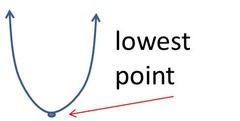
A patient is receiving chemotherapy for the treatment of cancer. The nurse anticipates nadir to occur in A. 2 days. B. 8 days. C. 15 days. D. 30 days

answer
B. 8 days. **Nadir is when the bone marrow and WBC are at their lowest**
question
The oncologist has told the patient that he or she has a benign tumor in the liver. The patient asks the nurse, "What is the main difference between benign and malignant tumors?" Which answer by the nurse is correct? 1 "Malignant tumors usually are encapsulated." 2 "Malignant tumors have a rare recurrence rate." 3 "Benign tumors do not invade and spread to other organs." 4 "Malignant tumors require less nutrients for their cells than benign tumors."
answer
3 "Benign tumors do not invade and spread to other organs." The ability of malignant tumor cells to invade and metastasize is the major difference between benign and malignant neoplasms. Benign tumors usually are encapsulated; metastasis is absent, and recurrence is rare. Malignant tumors rarely are encapsulated, are capable of metastasis, and are capable of recurring.
question
The nurse providing care for a patient with suspected cancer recalls that the only diagnostic procedure that is definitive for a diagnosis of cancer is: 1 MRI 2 Biopsy 3 CT scan 4 Tumor marker
answer
2 Only a biopsy is a definitive means of diagnosing cancer, because it actually identifies the pathological cells. Many tests, such as MRI, CT scan, and tumor markers, are indicative of cancer, but they do not confirm the presence of cancer cells as examination of a specimen obtained by biopsy does.
question
Seven Warning Signs of Cancer (CAUTION)
answer
C:hange in bowel or bladder habits A: sore throat that doesn't heal U:nusual bleeding or discharge T:hickening or lump in breast or elsewhere I:ndigestion or difficulty swallowing O:obvious change in wart or mole N:agging cough or hoarseness



